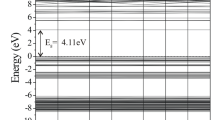Abstract
Adsorption of hydrogen sulfide (H2S) on the external and internal surface of Zn12O12 nanocluster was studied by using density functional calculations. The results indicate that the H2S molecule is physically adsorbed or chemically dissociated by the nanocluster. It was found that the H2S molecule can dissociate into –H and–SH fragments, suggesting that the nanocluster might be a potential catalyst for dissociation of the H2S molecule. Also, dissociation of H2S to S species in internal surface of the Zn12O12 nanocluster is energetically impossible. The HOMO–LUMO energy gap of H2S dissociation configuration is changed about 27.68 %, indicating that the electronic properties of the nanocluster by dissociation process have strongly changed.



Similar content being viewed by others
References
G. R. Gu and T. Ito (2011). Appl. Surf. Sci. 257, 2455–2460.
X. Qiu, J. Y. Howe, H. M. Meyer, E. Tuncer, and M. P. Parantharman (2011). Appl. Surf. Sci. 257, 4057–4081.
Y. L. Wu, A. I. Y. Tok, F. Y. C. Boey, X. T. Zeng, and X. H. Zhang (2007). Appl. Surf. Sci. 253, 5473–5479.
J. D. Prades, A. Cirera, and J. R. Morante (2009). Sens. Actuators B 142, 179–184.
J. Duan, X. Huang, and E. Wang (2006). Mater. Lett. 60, 1918–1921.
U. Ozgur, Ya. I. Alivov, C. Liu, A. Teke, M. A. Reshchikov, S. Dogan, V. Avrutin, S. J. Cho, H. Morkoc, and (2005). J. Appl. Phys. 98, 041301.
C. Klingshirn (2007). Chem. Phys. Chem. 8, 782–803.
L. Schmidt-Mende and J. L. MacManus-Driscoll (2007). Mater. Today 10, 40–48.
I. I. Novochinskii, C. S. Song, X. L. Ma, X. S. Liu, L. Shore, J. Lampert, and R. J. Farrauto (2004). Energy Fuels 18, 576–583.
H. Y. Yang, R. Sothen, D. R. Cahela, and B. J. Tatarchuk (2008). Ind. Eng. Chem. Res. 47, 10064–10070.
I. Rosso, C. Galletti, M. Bizzi, G. Saracco, and V. Specchia (2003). Ind. Eng. Chem. Res. 42, 1688–1697.
J. Lin, J. A. May, S. V. Didziulis, and E. I. Solomon (1992). J. Am. Chem. Soc. 114, 4718–4727.
H. L. Fan, Y. X. Li, C. H. Li, H. X. Guo, and K. C. Xie (2002). Fuel 81, 91–96.
P. R. Westmoreland and D. P. Harrison (1976). Environ. Sci. Technol. 10, 659–661.
L. Ling, J. Wuc, J. Song, P. Han, and B. Wang (2012). Comput. Theor. Chem. 1000, 26–32.
J. A. Rodriguez and A. Maiti (2000). J. Phys. Chem. B 104, 3630–3638.
X. D. Gao, X. M. Li, and W. D. Yu (2004). Appl. Surf. Sci. 229, 275–281.
A. Al-Sunaidi and S. Goumri-Said (2011). Chem. Phys. Lett. 507, 111–116.
A. D. Becke (1988). Phys. Rev. A 38, 3098–3100.
J. Beheshtian, M. Kamfiroozi, Z. Bagheri, and A. Ahmadi (2012). Comput. Mater. Sci. 54, 115–118.
M. Schmidt, et al. (1993). J. Comput. Chem. 14, 1347.
Author information
Authors and Affiliations
Corresponding author
Rights and permissions
About this article
Cite this article
Peyghan, A.A., Baei, M.T. & Hashemian, S. ZnO Nanocluster as a Potential Catalyst for Dissociation of H2S Molecule. J Clust Sci 24, 341–347 (2013). https://doi.org/10.1007/s10876-013-0553-8
Received:
Published:
Issue Date:
DOI: https://doi.org/10.1007/s10876-013-0553-8




